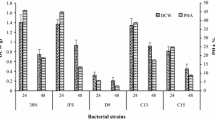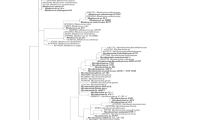Abstract
To get insight in the biodegradation and potential read-across of fatty acid amides, N-[3-(dimethylamino)propyl] cocoamide and N-(1-ethylpiperazine) tall oil amide were used as model compounds. Two bacteria, Pseudomonas aeruginosa PK1 and Pseudomonas putida PK2 were isolated with N-[3-(dimethylamino)propyl] cocoamide and its hydrolysis product N,N-dimethyl-1,3-propanediamine, respectively. In mixed culture, both strains accomplished complete mineralization of N-[3-(dimethylamino)propyl] cocoamide. Aeromonas hydrophila PK3 was enriched with N-(1-ethylpiperazine) tall oil amide and subsequently isolated using agar plates containing dodecanoate. N-(2-Aminoethyl)piperazine, the hydrolysis product of N-(1-ethylpiperazine) tall oil amide, was not degraded. The aerobic biodegradation pathway for primary and secondary fatty acid amides of P. aeruginosa and A. hydrophila involved initial hydrolysis of the amide bond producing ammonium, or amines, where the fatty acids formed were immediately metabolized. Complete mineralization of secondary fatty acid amides depended on the biodegradability of the released amine. Tertiary fatty acid amides were not transformed by P. aeruginosa or A. hydrophila. These strains were able to utilize all tested primary and secondary fatty acid amides independent of the amine structure and fatty acid. Read-across of previous reported ready biodegradability results of primary and secondary fatty acid amides is justified based on the broad substrate specificity and the initial hydrolytic attack of the two isolates PK1 and PK3.




Similar content being viewed by others
References
AkzoNobel (2010) Surface chemistry general catalog, Akzo Nobel Surface Chemistry LLC. https://www.akzonobel.com/surface/brands_products/. Accessed 4 Mar 2013
Brown JE, Brown PR, Clarke PH (1969) Butyramide-utilizing mutants of Pseudomononas aeruginosa 8602 which produce an amidase with altered substrate specificity. J Gen Microbiol 57:273–285
Clarke PH (1980) The utilization of amides by microorganisms. In: Payne JW (ed) Microorganisms and nitrogen sources transport and utilization of amino acids, peptides, proteins, and related substrates. Wiley, New York, pp 537–562
Denger K, Mayer J, Hollemeyer K, Cook AM (2008) Amphoteric surfactant N-oleoyl-N-methyltaurine utilized by Pseudomonas alcaligenes with excretion of N-methyltaurine. FEMS Microbiol Lett 288(1):112–117
EPA (2001) Robust summaries & test plans, fatty nitrogen derived amides. U.S. Environmental Protection Agency, High Production Volume (HPV) challenge: 10–34. http://www.epa.gov/HPV/pubs/summaries/fantdrad/c13319tc.htm. Accessed 23 Mar 2013
European Chemical Bureau (ECB) (2000a) Substance ID: 140-31-8 IUCLID (International uniform chemical information) database: 13–14. http://esis.jrc.ec.europa.eu/doc/IUCLID/data_sheets/140318.pdf. Accessed 30 Dec 2013
European Chemical Bureau (ECB) (2000b) Substance ID: 109-55-7 IUCLID (International uniform chemical information) database: 23–24. http://esis.jrc.ec.europa.eu/doc/IUCLID/data_sheets/109557.pdf. Accessed 30 Dec 2013
Fournand D, Arnaud A (2001) Aliphatic and enantioselective amidases: from hydrolysis to acyl transfer activity. J Appl Microbiol 91:381–393
Hauthal HG (2009) Sustainable detergents and cleaners, progress on ingredients, nanoparticles, analysis, environment. Fourth European Detergents Conference Report. Tenside Surf Det 46(1):53–62
Helbling DE, Hollender J, Kohler HPE, Fenner K (2010) Structure-based interpretation of biotransformation pathways of amide-containing compounds in sludge-seeded bioreactors. Environ Sci Technol 44:6628–6635
Johansson I (2003) Amides, fatty acids. In: Kirk-Othmer (ed) Encyclopedia of chemical technology, vol 2. Wiley, New York, pp 442–462
Kagayama T, Ohe T (1990) Purification and properties of an aromatic amidase from Pseudomonas sp. GDI 211. Agric Biol Chem 54(10):2565–2571
Karleskind A (1996) In oils and fats manual: a comprehensive treatise. Lavoisier Technique et documentation, Paris
Kelly M, Clarke PH (1962) An inducible amidase produced by a strain of Pseudomonas aeruginosa. J Gen Microbiol 27:305–316
Nawaz MS, Chapatwala KD, Wolfram JH (1989) Degradation of acetonitrile by Pseudomonas putida. Appl Environ Microbiol 55(9):2267–2274
Nawaz MS, Heinze TM, Cerniglia CE (1992) Metabolism of benzonitrile and butyronitrile by Klebsiella pneumonia. Appl Environ Microbiol 58(1):27–31
Nawaz MS, Khan AA, Seng JE, Leakey JE, Siitonen PH, Cerniglia CE (1994) Purification and characterization of an amidase from an acrylamide-degrading Rhodococcus sp. Appl Environ Microbiol 60(9):3343–3348
OECD Guideline for Testing of Chemicals (1992) Degradation and accumulation, no. 301: ready biodegradability. OECD, Paris Cedex
Ratledge C (1994) Biodegradation of oils, fats and fatty acids. In: Ratledge C (ed) Biochemistry of microbial degradation. Kluwer, Amsterdam, pp 89–141
Sharma M, Sharma NN, Bhalla TC (2009) Amidases: versatile enzymes in nature. Rev Environ Sci Biotechnol 8:343–366
Sonke T, Kaptein B (2012) Hydrolyis of amides. In: Drauz K, Gröger H, May O (eds) Enzyme catalysis in organic synthesis, 3rd edn. Wiley, Weinheim, pp 561–650
Thiéry A, Maestracci M, Arnaud A, Galzy P (1986) Acyltransferase activity of the wide spectrum amidase of Brevibacterium sp. R312. J Gen Microbiol 132:2205–2208
van Ginkel CG (2007) Ultimate biodegradation of ingredients used in cleaning agents. In: Johansson, Somasundaran (eds) Handbook for cleaning/decontamination of surfaces, vol 2, 1st edn. Elsevier, Amsterdam, pp 655–694
van Ginkel CG, Stroo CA (1992) Simple method to prolong the closed bottle test for the determination of the inherent biodegradability. Ecotoxicol Environ Saf 24:319–327
van Ginkel CG, Dijk JB, Kroon AGM (1992) The metabolism of hexadecyltrimethylammonium chloride in Pseudomonas B1. Appl Environ Microbiol 58(9):3083–3087
Villarreal DT, Turco RF, Konopka A (1994) A structure-activity study with aryl acylamidases. Appl Environ Microbiol 60(11):3939–3944
Vishniac W, Santer M (1957) The Thiobaccilli. Bacteriol Rev 21:195–213
Yamane M, Toyo T, Inoue K, Sakai T, Kaneko Y, Nishiyama N (2008) Aquatic toxicity and biodegradability of advanced cationic surfactant APA-22 compatible with the aquatic environment. J Oleo Sci 57(10):529–538
Acknowledgments
Financial support for the research described in this paper has been provided by AkzoNobel Surface Chemistry
Author information
Authors and Affiliations
Corresponding author
Rights and permissions
About this article
Cite this article
Geerts, R., Kuijer, P., van Ginkel, C.G. et al. Microorganisms hydrolyse amide bonds; knowledge enabling read-across of biodegradability of fatty acid amides. Biodegradation 25, 605–614 (2014). https://doi.org/10.1007/s10532-014-9685-2
Received:
Accepted:
Published:
Issue Date:
DOI: https://doi.org/10.1007/s10532-014-9685-2




